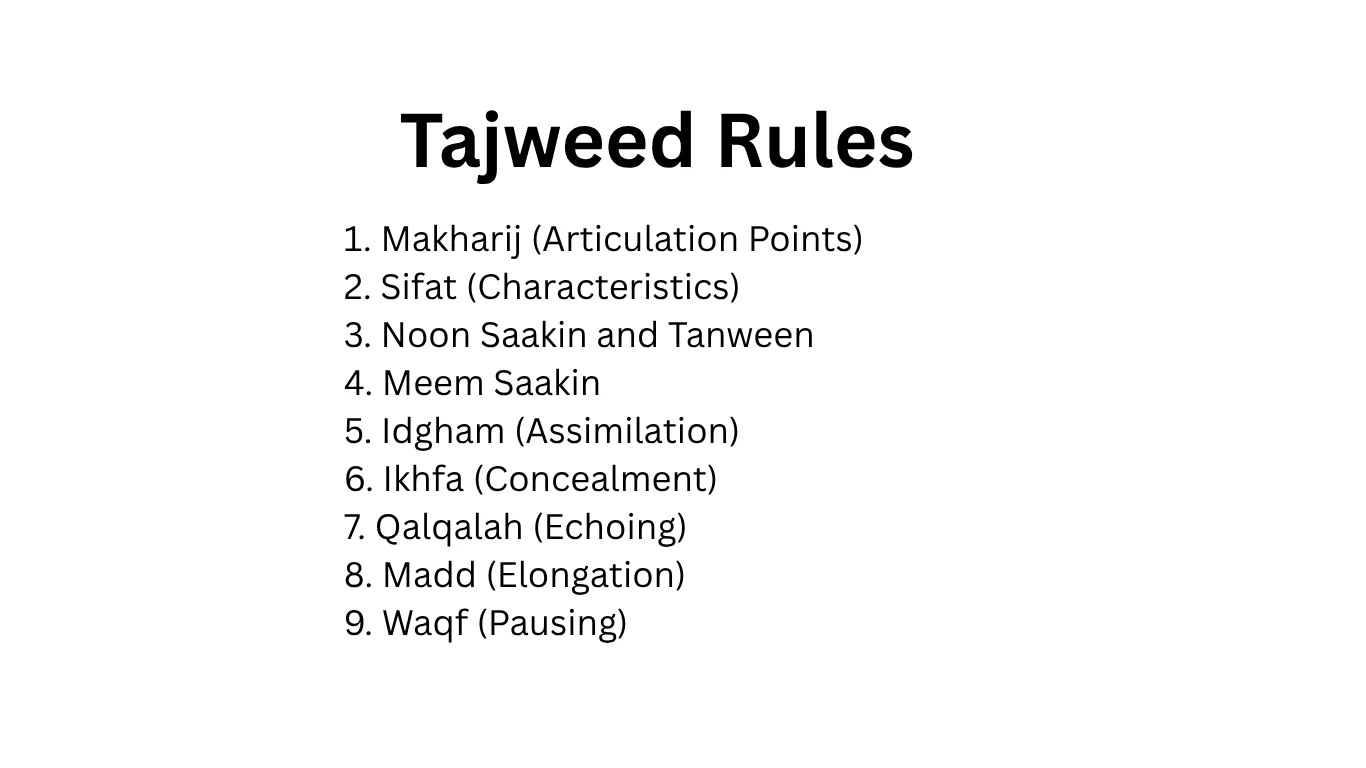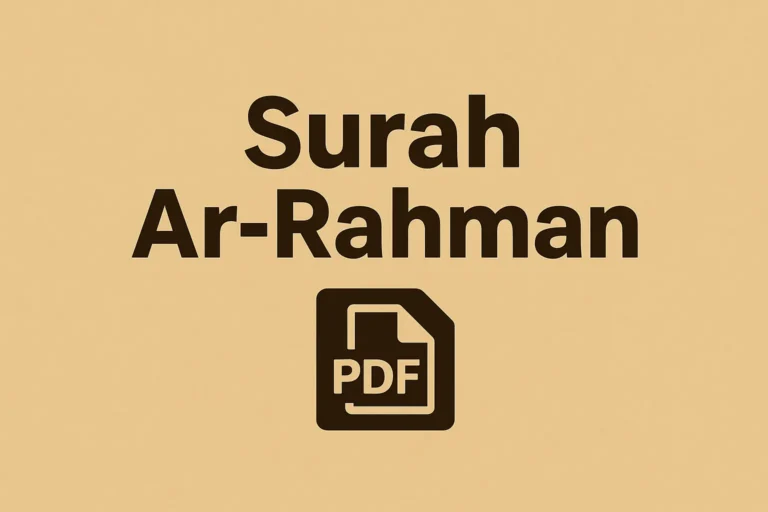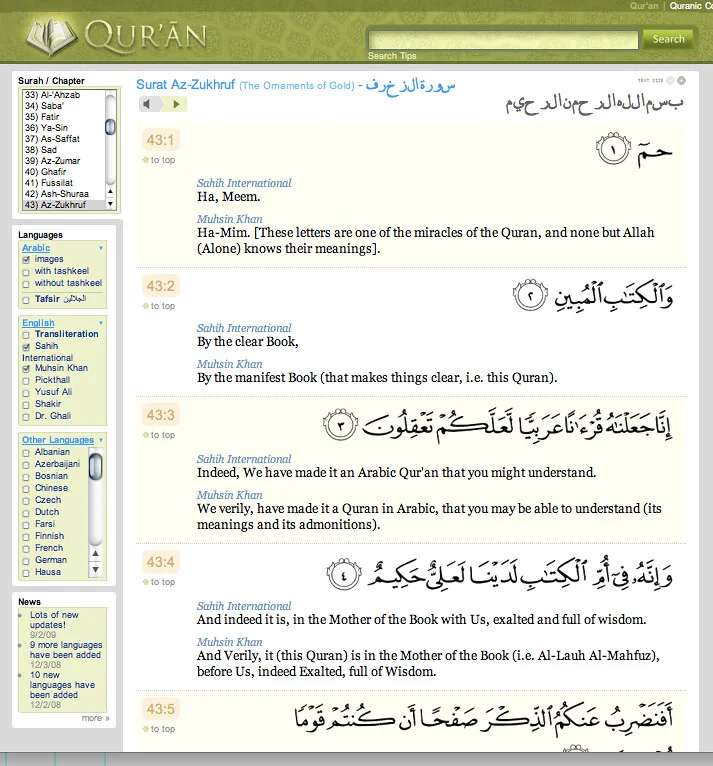Master Tajweed Rules for Spiritual and Practical Benefits
Tajweed is derived from the Arabic root “جود” (j-w-d), which means “to make better” or “to improve.” Tajweed rules govern the correct pronunciation of various Arabic letters and words. The purpose of implementing rules is to ensure the precise recitation of the Holy Quran as it was revealed to the last Holy Prophet Hazrat Muhammad (PBUH). Muslims can consider the Tajweed Quran course to understand and apply these rules for the beautiful and accurate recitation.
What Is Tajweed?
Tajweed is the study of the articulation and characteristics of Arabic letters to beautify the recitation. It ensures ideal pronunciation of letters in the ideal placement of the throat or mouth in the proper manner and with the ideal quality. Therefore, rules for Tajweed preserve the divine message and linguistic integrity.

Importance of Tajweed in Muslims’ Life
The application of Tajweed rules improves the recitation’s beauty while ensuring the precise understanding of the divine message. It also reflects the respect for the sacred Quranic text while enhancing the spiritual growth.
Tajweed maintains the original message which was revealed to the Prophet Muhammad(ﷺ). You must remember that the risk of modifying Quranic meanings can result in various interpretations of a single verse. Therefore, you can explore an online Tafseer course to read different interpretations.
Reciting the Holy Quran with specific rules improves the spiritual growth for the listeners and reciters. It offers a sense of connection, reflection, and reverence for Allah Almighty’s message. Therefore, the basic rules of Tajweed are the ideal form of devotion and worship for Muslims.
Let’s explore the rules governing the ideal Tajweed to read the holy book beautifully.
1. Makharij (Articulation Points)
The Arabic alphabet includes 28 letters, each starting from a particular point in the vocal system. The correct identification and pronunciation of the articulation points are necessary for accurate Quranic recitation. These points are as follows:
- Lips (Shafatan): Includes the letters such as ب (Bāʾ) and م (Mīm).
- Nasal Passage (Khayshūm): Features letters such as م (Mīm) and ن (Nūn) for nasalization.
- Tongue (Lisān): Surround letters like ص (Ṣād), د (Dāl), and ت (Tāʾ).
- Throat (Halaq): Consists of letters such as ح (Ḥāʾ) and ع (ʿAyn).
Each of the letters has a distinctive origin, ensuring the precision and clarity in the Quran pronunciation while maintaining linguistic integrity. It also helps you to memorize Quran effectively.
Importance
Makharij ensures pronunciation of every Arabic letter from the perfect position of the throat or mouth. It prevents one letter from sounding like another. Articulation is crucial for Quran recitation, conveying the divine message to every reciter without distortion.
You can confuse different sounds, such as ك (kāf), ق (qāf), ص (ṣād), and س (sīn), without a proper understanding of the Makharij. It is important to remember that each word has its own origin and meaning.
2. Sifat (Characteristics)
Each letter owns the inherent characteristics like being light (مرقق) or heavy (مفخم), clear (ظاهر), or nasal (غنة). Knowing each trait ensures ideal sound for recitation of each Arabic letter.
Let’s take a look at the inherent qualities of each Arabic letter for pronunciation. You can consider an online Qirat course to recite words with their characteristics.
- Light (مرقق – Murakkak): A lighter articulation tone for letters like ت (Tāʾ) and ب (Bāʾ).
- Heavy (مفخم – Mufakhkham): The deeper pronunciation with a resonant sound for letters like ط (Ṭāʾ) and ق (Qāf).
- Clear (ظاهر – Ẓāhir): The clear pronunciation of letters like ر (Rāʾ) and ل (Lām) without nasalization.
- Nasal (غنة – Ghunna): It produces the nasal sound for letters like ن (Nūn) and م (Mīm), particularly if they have no vowel (sukoon).
Recognition of these characteristics is essential for reciting with the correct sound, which improves accuracy and beauty.
Importance
Sifat offers uniqueness and depth to each Arabic letter, differentiating the sounds that are similar. For instance, ق (qāf) and ف (fāʼ) seem alike to beginners, but their Sifat, such as heaviness vs. softness, differentiate them.
The correct application of characteristics results in balanced and clear recitation while avoiding distortion or monotony. Sifat is all about gaining knowledge about the personality of every letter, improving the spiritual and emotional delivery of the different verses. Moreover, you consider the best English translation of Quran to understand these letters in your native language.
3. Noon Saakin and Tanween
These Tajweed rules are crucial for the pronunciation of the silent “Tanween” (ً ٍ ٌ) and “Noon” (ن). These letters can be pronounced nasalized, assimilated, or clearly, depending on their placement in verses.
- Idgham (إدغام): The “Noon” is merged with the next letter, usually with the nasalization when followed by letters like م (Mīm), ر (Rāʾ), or ي (Yāʾ).
- Ikhfā (إخفاء): The “Noon” is partially hidden, conveying a nasalized sound when followed by letters such as ت (Tāʾ), ذ (Dhāl), or ص (Ṣād).
- Iqlāb (إقلاب): The “Noon” is modified into a “Mīm” sodn with nasalization when followed by the letter ب (Bāʾ).
- Izhar (إظهار): The “Noon” is pronounced without nasalization, ensuring the clear sound when followed by letters such as ح (Ḥāʾ), ع (ʿAyn), or ء (Hamzah).
These rules ensure the accurate and smooth flow of the recitation, maintaining the intended meaning of different verses. Therefore, you can dive deep into the Quran word to word with a comprehensive understanding of different words.
Importance
This rule involves the melody and flow of the recitation, allowing reciters to maintain the clear and smooth transition between words. Therefore, you can easily maintain the meaning and rhythm of different Arabic letters and words. Clarity and nasalization allow listeners to differentiate between similar word endings, ensuring a better understanding of each verse.
4. Meem Saakin
The pronunciation is influenced by the following letter if a “Meem” (م) is silent. It results in the particular Tajweed principles for nasalization or clarity. Moreover, the pronunciation is impacted by the following letter when “Meem” (م) includes a sukoon (no vowel).
- Idgham (إدغام): Two “Meem”s are combined and pronounced with nasalization when a shadda (مّ) follows a “Meem.”
- Ikhfā (إخفاء): The “Meem” is half-concealed, ensuring a nasalized sound when followed by the letter ب (Bāʾ).
- Ithār (إظهار): The clear pronunciation of “Meem” without nasalization when followed by letters other than م (Mīm) and ب (Bāʾ).
These Tajweed rules are ideal to learn Quran and the correct reciting of the “Meem,” ensuring the marvelous beauty and clarity of recitation.
Importance
This rule is perfect for the pronunciation of the letter Meem (م) during its silence, particularly in words like يَوْمٌ مَوعُود. Proper use prevents confusion with other lip-based or nasal sounds while maintaining the natural symmetry and rhythm of the recitation.
Meem Saakin also stresses the consistent application of nasal sounds, resulting in the harmonious tone, making the recitation more spiritual for reciters.
5. Idgham (Assimilation)
Assimilation occurs when a letter combines the following letter, forming a smoother recitation flow. It can be with or without nasalization, depending on the involvement of letters.
- With Ghunna (غنة): The “Tanween” or “Noon” is combined with nasalization when a letter is included in nasalized letters, such as و (Wāw), م (Mīm), ن (Nūn), or ي (Yāʾ).
- Without Ghunna: The “Tanween” or “Noon” is combined without nasalization when a letter is part of non-nasalized letters such as ل (Lām) or ر (Rāʾ).
It helps you understand and apply Idgham rules, offering a harmonious and smoother recitation.
Importance
Idgham is essential for the connected and smoother recitation. It combines the letters together, ensuring a better flow. A balance between merging results in the unrecognizability of words, while avoiding Idgham results in the robotic recitation.
You must remember that proper Idgham ensures accuracy and beauty. It also preserves meanings while maintaining the melodious and natural flow.
6. Ikhfa (Concealment)
Ikhfa is a partial blending of a letter with the following one, conveying a nasalized sound. This subtle rule enhances the beauty of recitation. It is applicable when these 15 Ikhfā letters follow “Tanween” or “Noon.”
ص ذ ث ك ج ش ق س د ط ز ف ت ض ظ
For instance, the “Noon” is partially hidden and nasalized in the word “مِنْ صَارَ” (min ṣāra) due to the presence of the trigger Ikhfā letter ṣād (ص). Moreover, the Noon Sakinah (نْ) in “min” is not entirely merged and pronounced clearly as in Idghām. It produces a lighter nasal sound, combining seamlessly into the ṣād while maintaining the preservation of the “Noon.” You can get an Ijazah for this rule after mastering it.
Importance
It ensures smooth blending without reducing clarity. This ideal rule is very impactful, offering the nasal tone to improve the recitation melody. Ikhfa does not compromise on the unique identity of each letter. It commonly appears in the Holy Quran, which means proper application contributes to the professional and consistent recitation.
7. Qalqalah (Echoing)
Specific letters (ق, ط, ب, ج, د) result in a bouncing sound when they include a sukoon. The echoing effect of these letters is familiar as Qalqalah. It happens when one of these letters: ق، ط ب، ج، د appears in the silent state.
These Qalqalah letters ensure the echo-like pronunciation. This echoing adds energy and clarity to the recitation, particularly when stopping at the end of a verse. You can master Qalqalah before learning dua for Quran Khatam. The three levels of Qalqalah in Tajweed rules are as follows:
- Qalqalah Akbar (Strongest): It applies in conditions of a very strong stop with emphasis, particularly in Waqf during the final letters of words.
- Qalqalah Kubra (Major): It occurs when the Qalqalah letter comes at the end of a word and stops upon like الْفَلَقْ.
- Qalqalah Sughra (Minor): It happens when a letter appears in the center of a word while carrying a permanent sukoon like أَقْدَرَ.
There is no insertion of an additional vowel because it’s an excellent bounce without syllabicity. You can practice Qalaqalah to sharpen your articulation skills while maintaining the flow and rhythm of recitation.
Importance
Qalqalah ensures the ideal punch and clarity to silent letters, particularly at the end of verses or words. The words can sound weaker without Qalqalah, reducing the impact and strength of the divine message. Therefore, this rule offers the phenomenal emphasis and rhythm, allowing an online Quran reciter to memorize Quranic phrases easily.
8. Madd (Elongation)
Madd represents the elongation of vowels. There are various kinds of Madd in Tajweed:
- Madd Asli: A natural elongation.
- Madd Far’i: Secondary elongation, with particular principles.
The literal meaning of Madd is “to stretch” or “to extend.” It refers to the elongation of particular vowel sounds in the Tajweed principles. Two major types of Madd are below:
A. Madd Asli (Natural Madd)
A basic form of elongation, stretching a vowel for two counts, usually happens with the longer vowels:
- Alif (ا) is anticipated by a Fatha
- Waw (و) is anticipated by a Dhammah
- Yaa (ي) is anticipated by a Kasrah
Example: Atif will be elongated for 2 counts in the case of قَالَ.
B. Madd Far’i (Secondary Madd)
This elongation is impacted by factors like the sukoon or hamzah that appear after the vowel. You can take a look at the following types of secondary Madd in the Tajweed rules for Quran memorization course.
- Madd ‘Ārid lil-Sukoon: An elgnation occurs when a word ends with a temporary sukoon and a long vowel due to a pause like الْعَالَمِينَ.
- Madd Lazim (Mandatory Madd): A sukoon follows a vowel in the same word, like الصَّاخَّةُ.
- Madd Munfasil (Separated Madd): When a long vowel comes at the end of a word, and the next word starts with a hamzah like فِيمَا أُنْزِلَ.
- Madd Muttasil (Connected Madd): This madd occurs when hamzah and the vowel come together in the same word, like جَاءَ.
It is important to remember that Madd enhances the recitation’s beauty while maintaining the Tajweed structure and right meaning.
Importance
Madd rules are essential for the ideal musical structure of the Quran. The elongation of specific sounds intentionally allows you to develop an emotional cadence and depth. It can capture the attention while conveying the softness, depending on the specific context of the Quran in English.
Some Madd types are grammatically necessary because ignoring them can alter the meanings or sentence structure. Therefore, you need to apply the Madd to avoid serious issues in the recitation.
9. Waqf (Pausing)
It is necessary to understand where and how to pause in the recitation. Waqf signs show the essential, preferable, and permissible stops, allowing readers to correct meaning and pronunciation.
It has a prominent role in the preservation of the textual fluency and meaning. You must consider that improper stopping can modify the meaning. There are different types of Waqf in Tajweed.
A. Waqf Hasan (Good Stop)
A natural stop or pause conveying a better linguistic sense. It usually comes at the end of an entire sentence or idea. The proper understanding of Waqf signs like س (pause without breath), ج (optional), ق (possible stop), or ط (complete stop) allows you to recite with majesty in online Quran classes.
B. Waqf Jaiz (Permissible Stop)
It is a recommended stop that enables the reciters to take a natural break or breath while ensuring coherence.
C. Waqf Lazim (Mandatory Stop)
It is an essential stop, which is represented by a small م above the text. This Waqf Lazim in Tajweed indicates that you must pause recitation at the specific point to preserve the meaning. Moreover, not pausing can result in misinterpretation.
D. Waqf Mamnu’ (Forbidden Stop)
A forbidden pause is presented by a small لا (Lam-Alif). It indicates that you must not stop here because it can alter the meaning of a word or verse.
Importance
Waqf in the Tajweed rules is important for the preservation of meaning. Stopping in the wrong place can lead to a modified meaning or misunderstanding of the entire verse during Quran lessons. For example, pausing at “لَا إِلَٰهَ” (There is no god…) without continuing to “إِلَّا اللَّهُ” (…except Allah) is wrong. Therefore, Waqf signs have become the ultimate guide for pacing and breathing, encouraging reciters to avoid fatigue while ensuring the ideal clarity for listeners.
Spiritual Benefits of Applying Tajweed Rules
- Fulfillment a Divine Command: Allah Almighty says in the Holy Quran: “وَرَتِّلِ الْقُرْآنَ تَرْتِيلًا”. “And recite the Qur’an with the measured recitation” – Surah Al-Muzzammil 73:4. Therefore, Tajweed is beneficial for obeying the command.
- Improve Connection with Allah: When you are reciting the holy book, it is essential to enhance your reflection, understanding and connection with the divine message.
- Get Rewards: The Holy Prophet Muhammad (PBUH) said: “The one who is proficient in the Qur’an will be with the honorable and obedient scribes (angels)…” – Bukhari & Muslim. The correct recitation through the eLearning Quran helps you gain spiritual rewards in this world and the Hereafter.
- Preserve the Original Beauty of Quran: It is necessary to maintain the rhythm and eloquence of the divine book by reciting it as revealed to the Holy Prophet Muhammad (ﷺ).
Practical Benefits of Tajweed Principles
- Avoid Mispronunciations: Tajwid ensures that reciters do not intentionally modify the meaning of words. Changing of meanings can usually occur due to incorrect pronunciation. Therefore, practical practice helps you to get rid of mispronunciations.
- Enhance Clarity and Confidence: The ideal pronunciation of Arabic letters and words according to Tajweed rules ensures clarity and fluency. It helps you in the public recitation or prayer.
- Ensure Easier Memorization: The ideal Structure and rhythm of Tajweed help you throughout the memorization journey at the Quran institute.
- Better Listening Experience: Beautiful and clear recitation touches every listener’s heart. It ensures a powerful and peaceful impact, whether you are listening to or reading the Quran.
How to Master Tajweed Rules
Mastering Tajweed is essential because it is the ideal art of correctly pronouncing the various verses of the Holy Qur’an. It has become necessary for every student to understand the Quran with Tajweed while deepening the spiritual connection. Here is how you can learn and master the rules for Tajweed.
1. Start with the Fundamentals of Arabic Phonetics
When you are looking to master the complex rules, it is crucial to develop a solid foundation by learning the correct pronunciation of each Arabic letter. You can focus on the articulation points and attributes when starting to master Tajweed.
It is a good strategy to consider the Tajweed books with clear illustrations of makharij and audio support. Therefore, you can master these basics of phonetics at the leading online Quran academy.
2. Learn Tajweed Rules in Smaller and Manageable Sections
There are core rule categories that include Meen Sakinah rules, Noon Sakinah and Tanween, and elongation. You must consider reviewing and repetition, which are key in mastering the proper Tajweed.
3. Listen to Expert Reciters Daily
When you are looking to improve your Tajweed, it becomes necessary to listen to qualified and expert reciters. You can consider the recitations of reciters like Sheikh Mishary Alafasy and Abdul Basit.
It is good to prefer an audio Qur’an with visuals to listen and visualize different letters and words to enhance the learning. Moreover, you can also repeat while listening to a reciter to mimic pace and pronunciation. Consistency has immense importance because a 10-minute focus on proper listening can yield phenomenal results.
4. Recite with a Qualified Teacher
Tajweed is traditionally passed via oral transmission. A certified Quran teacher can assist you in the following ways:
- Correct mistakes
- Give real-time support
- Building confidence and fluency means you need to get in touch with a tutor who helps you throughout the beginner to advanced level mastery of Tajweed.
5. Study the Mushaf Al-Tajweed (Color-Coded Quran)
This specific Mushaf describes Tajweed rules in color, making it easy for you to identify where to elongate and pause. Moreover, it allows you to understand which rule is applicable to a particular word. Mushaf Al-Tajweed acts as a guide embedded in the Qur’an.
6. Use Digital Apps and Tools
Different apps, such as Tajweed Quran or Learn Tajweed, provide the proper lessons, audio, and quizzes, aligning with your learning level. The interactive interface of these apps keeps learners motivated with regular practice. Our Islamic educational center enables you to master Tajweed in an interactive environment.
7. Revise Tajweed Rules Regularly and Teach Others
Consistency is key to mastery of Tajweed. Teaching it to others allows you to review and refine your Tajweed skills. Moreover, learning and teaching Tajweed allows you to act upon: “The best among you are those who learn the Qur’an and teach it.” (Bukhari)
Conclusion
Tajweed mastery is more than just learning and applying the rules. It is an honored and sacred journey of learning the words of Allah Almighty. Tajweed transforms the Quran reading with mindful and precise pronunciation. You can easily reflect your reverence and love for the Holy Qur’an, whether you are a beginner or improving your recitation.
This lifelong commitment enhances your spiritual connection with Allah Almighty and enriches prayers. Tajweed rules are not just for beautifying the sound but also for preserving the meaning while experiencing spiritual growth. Let’s learn the fundamentals of Tajweed from Mahad Al Islami Lil Banat and gain the spiritual rewards!
FAQs
Answer: Ikhfa, Iqlab, Idgham, and Izhaar are the rules of Tajweed for mastering Noon Sakinah and Tanween.
Answer: This rule modifies the sound of a Tanween ( ) or Noon Sakinah ( نْ ) to “Meem” ( م ) when a letter “Baa” ( ب ) follows it.
Answer: The dry parts of the bottom and top lips touching form the Makharij of م (meem).
Answer: This rule changes the sound of a word. For instance, Tanween or Noon Sakinah changes into Meem and is read with Ghunnah if Baa appears before Noon.
Answer: The meaning of Sifaat is the qualities or characteristics of various Arabic letters that differentiate them from each other during recitation.
Answer: This rule merges sounds, particularly when a letter follows a Tanween or Noon Sakinah, into the following letter.
Answer: The Tanween or Noon is pronounced clearly without nasalization when one of these letters (ء, هـ, ع, ح, غ, خ) follows a non-voweled Tanween (ً، ٍ، ٌ) or Noon (ن).








